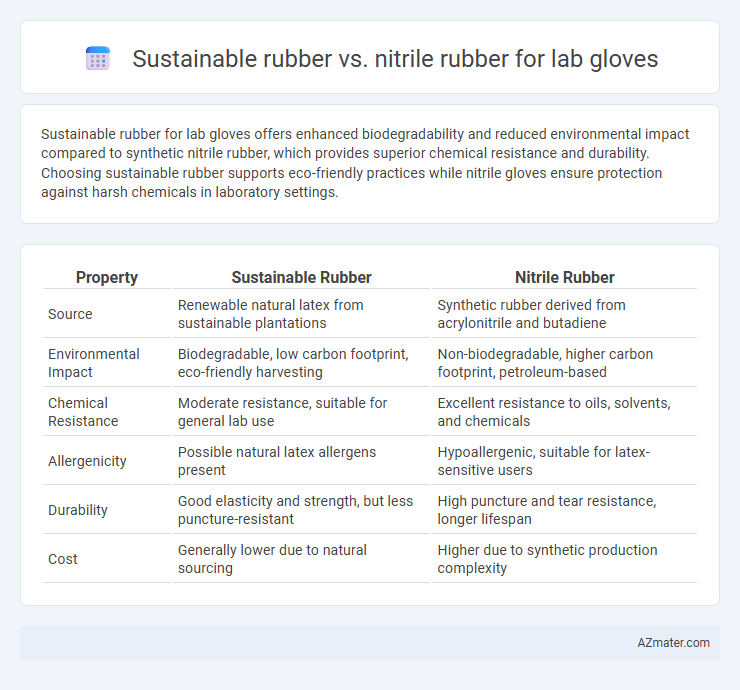Sustainable rubber for lab gloves offers enhanced biodegradability and reduced environmental impact compared to synthetic nitrile rubber, which provides superior chemical resistance and durability. Choosing sustainable rubber supports eco-friendly practices while nitrile gloves ensure protection against harsh chemicals in laboratory settings.
Table of Comparison
| Property | Sustainable Rubber | Nitrile Rubber |
|---|---|---|
| Source | Renewable natural latex from sustainable plantations | Synthetic rubber derived from acrylonitrile and butadiene |
| Environmental Impact | Biodegradable, low carbon footprint, eco-friendly harvesting | Non-biodegradable, higher carbon footprint, petroleum-based |
| Chemical Resistance | Moderate resistance, suitable for general lab use | Excellent resistance to oils, solvents, and chemicals |
| Allergenicity | Possible natural latex allergens present | Hypoallergenic, suitable for latex-sensitive users |
| Durability | Good elasticity and strength, but less puncture-resistant | High puncture and tear resistance, longer lifespan |
| Cost | Generally lower due to natural sourcing | Higher due to synthetic production complexity |
Introduction to Lab Glove Materials
Sustainable rubber, derived from natural latex trees, offers biodegradability and reduced environmental impact compared to synthetic nitrile rubber used in lab gloves. Nitrile rubber, a synthetic copolymer of butadiene and acrylonitrile, provides superior chemical resistance, puncture protection, and hypoallergenic properties ideal for laboratory applications. Choosing between sustainable natural rubber and nitrile rubber depends on balancing eco-friendliness with performance requirements in protective gloves.
What Is Sustainable Rubber?
Sustainable rubber is harvested using environmentally responsible methods that minimize deforestation and promote biodiversity, ensuring renewable and ethical sourcing of natural latex. This rubber is biodegradable and reduces ecological impact compared to synthetic alternatives like nitrile rubber, which is petroleum-derived and not biodegradable. In lab gloves, sustainable rubber offers a greener option with similar elasticity and comfort, while nitrile rubber provides superior chemical resistance and durability.
Understanding Nitrile Rubber
Nitrile rubber, a synthetic material derived from acrylonitrile and butadiene, offers excellent resistance to chemicals, punctures, and abrasions, making it ideal for lab gloves requiring durability and protection. Sustainable rubber alternatives, often sourced from natural rubber plantations with eco-friendly practices, emphasize biodegradability and reduced environmental impact but may lack the same chemical resistance as nitrile gloves. Understanding nitrile rubber's unique properties highlights its critical role in laboratory safety despite ongoing efforts to develop more sustainable glove materials.
Environmental Impact Comparison
Sustainable rubber lab gloves, derived from natural rubber sourced from responsibly managed plantations, offer significant environmental benefits due to their biodegradability and lower carbon footprint compared to nitrile gloves. Nitrile gloves, made from synthetic rubber derived from petroleum, contribute to higher greenhouse gas emissions and are less biodegradable, leading to increased landfill waste and environmental persistence. The production of sustainable rubber supports reduced chemical usage and promotes circular economy practices, making it a more eco-friendly choice in laboratory safety applications.
Manufacturing Processes and Resource Use
Sustainable rubber gloves are made using natural latex harvested from Hevea brasiliensis trees through eco-friendly tapping methods that minimize environmental impact, involving less energy-intensive processes and reduced chemical additives. Nitrile rubber gloves are synthesized from petroleum-based acrylonitrile and butadiene, requiring more complex chemical polymerization and vulcanization processes that consume significant fossil fuel resources and generate higher CO2 emissions. The manufacturing process of sustainable rubber emphasizes renewable materials and biodegradability, whereas nitrile focuses on durability and chemical resistance at the cost of greater non-renewable resource dependence.
Durability and Performance in Laboratory Settings
Sustainable rubber lab gloves, derived from natural rubber sources, offer excellent flexibility and tactile sensitivity, making them highly durable for repeated use in laboratory settings. Nitrile rubber gloves provide superior chemical resistance and puncture protection, ensuring enhanced performance when handling corrosive substances or sharp instruments. Both materials deliver reliable barrier protection, but nitrile excels in longevity under harsh chemical exposure, while sustainable rubber prioritizes eco-friendly biodegradability without compromising strength.
Chemical Resistance: Sustainable vs. Nitrile Rubber
Sustainable rubber used in lab gloves offers moderate chemical resistance suitable for handling less aggressive substances, while nitrile rubber provides superior resistance against a wide range of chemicals, including oils, acids, and solvents. Nitrile gloves demonstrate exceptional durability and puncture resistance, making them ideal for high-risk chemical exposure. Sustainable rubber gloves prioritize eco-friendly production but may require additional treatments to enhance chemical resistance comparable to nitrile alternatives.
Cost Analysis and Market Availability
Sustainable rubber lab gloves often incur higher initial costs due to eco-friendly sourcing and processing, whereas nitrile rubber gloves typically offer more cost-effective pricing driven by large-scale synthetic production. Market availability favors nitrile gloves, dominating approximately 70-80% of the lab glove sector due to their chemical resistance and hypoallergenic properties, while sustainable rubber gloves remain niche with limited but growing market penetration. Cost analysis reveals nitrile gloves benefit from lower raw material volatility, contributing to more stable pricing compared to the fluctuating costs associated with sustainable natural rubber.
User Safety and Allergen Considerations
Sustainable rubber lab gloves, derived from natural latex, offer superior elasticity and tactile sensitivity but pose allergen risks due to natural proteins, potentially causing Type I hypersensitivity reactions in users. Nitrile rubber gloves provide enhanced chemical resistance and durability with significantly lower allergenic potential, making them preferable for individuals with latex allergies and sensitive skin. Choosing nitrile gloves improves user safety by minimizing allergenic responses while maintaining protection against a wide range of laboratory chemicals.
Future Trends in Lab Glove Materials
Sustainable rubber, derived from natural sources like guayule and Hevea brasiliensis, is gaining traction in lab glove manufacturing due to its biodegradability and reduced environmental impact compared to synthetic nitrile rubber. Nitrile rubber remains popular for its superior chemical resistance and durability, but innovations in bio-based nitrile and improved manufacturing processes aim to reduce its carbon footprint. Future trends indicate a shift towards hybrid materials combining sustainable natural rubber with enhanced synthetic polymers to optimize performance, cost, and sustainability in laboratory glove applications.

Infographic: Sustainable rubber vs Nitrile rubber for Lab glove
 azmater.com
azmater.com